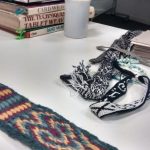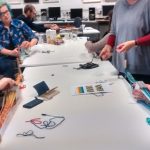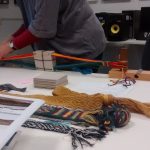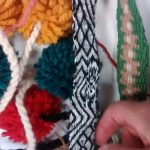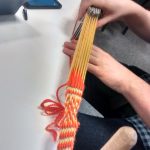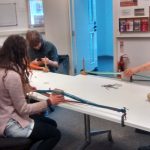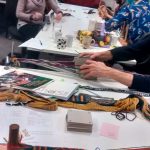The AHRC Weaving Codes, Coding Weaves project has drawn to an end. But happily, the work continues on within the ERC funded PENELOPE project. We may well update this blog in the future, but for now we are sharing our progress on the PENELOPE blog, please join us there!
Author: Alex McLean
Sonic pattern residency
I’m collaborating on a Sonic Pattern residency as part of the Inhabiting the Hack series, where four artists are invited to spend three days thinking about patterns in sound, textile, and technology. We started with a briliant half-day workshop on tablet weaving, lead by Sarah Williams. It was good to start a tech-focussed residency with some ancient tech, blowing our minds with the complexity which fell out from simple interactions between threads.
We first learned how to do the weaving, and then how to set up the warp, getting stuck in to the weaving first, and then get a feeling for how the threads themselves play their role in the cloth which emerges. Learning how to tablet weave backwards in this way worked well, and at some point Sarah noted how weavers generally seem to do things backwards. Instruction was around sitting position, tension, and how to establish a simple baseline to understanding what was going on, to avoid being scared off by the complexity. Learning Sarah’s techniques for how to warp up the tablets felt a little like taming a wild beast.
It turned out that Sarah is the Hon. Secretary of the association of Guilds of Spinners, Weavers and Dyers, which made it especially good to see how much she enjoyed the surprises which tablet weaving threw up even in our short workshop.
Following a thread when weft becomes warp
I’ve been prototyping models of a weave as a continuous thread, with some Haskell code. Here’s a quick demo which makes a plain weave, turns it into a 2-2 twill, then extends the weft to turn it into a warp, through which I then weave a plain weave:
Sonic Pattern debrief
The second Sonic Pattern and the Textility of Code series of symposia is a collaboration between Karen Gaskill (who is currently lead curator of Crafts Council innovation) and myself in a variety of guises. The second one took place earlier this week, and went really well, with a range of provocative talks and performances around craft, technology and touching the abstract.
Videos of some of the presentations and performances will be shared soon, but here are some quick reflections.
Particularly interesting were recurring themes across the quite different practices. One was exploration of the low brow, of working with peoples reactions against certain practices (even sneering), to confound expectations and break open misconceptions. This was most clearly seen both in Sharon Mossbeck‘s conceptual approach to cross-stitch, finding rejection both by groups of artists and craftspeople, and Theo Burt‘s phenomenal process-based reworkings of what could be called over-produced mainstream dance music. When the presenters were talking about making people aware of the rules in craft, different approaches to them, and how to encourage people to break them, it became difficult to keep in mind that we were talking about e.g. knitting and not politics.
Another theme I spotted was anxiety, for example artists expressing anxiety about mathematics despite textile work being full of numbers (the number 24 in particular cropping up as being a “good” one in textiles for it’s excellent divisibility). Also also the anxieties of self-identifying as a digital or analogue artist (although I’d argue all artists have always been both), and the differing statuses that people hold these terms at.
Another theme was the ‘long view’ shared by some presenters, that pattern (as a digital artform) is ancient, embedded in our culture, and as Matt Jones got across by sharing his perception of the world with us, basically everywhere. This long view is core to Weaving Codes, as our own Francesca Sargent spoke about in the symposium.
I could say much more but will save my words until the videos are up!
Sonic Pattern and the Textility of Code
We’re happy to be involved with the second Sonic Pattern and the Textility of Code event, to be held in Sheffield on 17th June 2015. It’s a collaboration with our Weaving Codes AHRC digital transformations project, the Crafts Council, and the EPSRC Communities and Culture Network+, co-curated by Karen Gaskill and myself (Alex McLean). The daytime discussion will include a presentation by Francesca Sargent on our project, including the Pattern Matrix.
It’ll be a full day of activity, with a symposium during the day featuring six diverse speakers, and an evening of audiovisual performances. All will explore how code, sound, image and threads allow us to both sense the abstract and conceptualise the tactile.
For more info, including booking details, see the Sonic Pattern website.
Making a warp weighted loom
Thanks to some funds from the Creative and Cultural Industries Exchange, University of Leeds, I’ve had the pleasure of a week’s research residency within Access Space in Sheffield, working within the highly creative environment of their fabrication/maker lab, to really get to grips with the ancient technology of the warp weighted loom, within the context of advanced digital manufacture.
This was a bit of a chicken-and-egg situation; I hadn’t really woven anything before, but wanted to make my own loom to learn on. Ellen suggested just lashing together four sticks and jumping in, which is what I did:
This loom was pretty terrible to use; wobbly, and I knew that making heddles out of paperclips was a bad idea, they constantly got caught on the wrong threads. But, I needed to learn from failure at this point, and despite all chance to fail, managed to weave (and unweave) a small piece of fabric. What I enjoyed most was tying the thread evenly spaced across the top beam for the warp threads to hang from. I’ve done a lot of knitting in the past, and this felt a lot like casting on. The knowledge for doing this was already in my fingers, a surprise to feel it there which made the confidence flow.
Next was the actual residency, beginning with an induction on lasercutting with John Moseley, my technical and engineering support for the week.
I was a bit worried about jumping into laser cutting, that making things via computer-aided design would distance me from the material. At least with the way John encouraged me to work, this did not turn out to be a problem at all. I sketched out some ideas, and then when straight to the laser cutter to see how they worked. This connected my thought and design processes with the material and the way of making, considering the order of cut, how to avoid cut pieces pivoting and blocking the laser, how the stickiness of the burnt MDF would help or hinder what I’m doing, and so on.. More than all this just holding the pieces in my hands made so much clear and avoided so much theoretical wrangling.
Within a couple of days I had a nicely balanced single-shaft loom with space for a camera and projector to be mounted:
The focus of the residency was not only to make a loom, but experiment with how it could be ‘augmented’ with contemporary technology. This is a bit of a tightrope, because the warp weighted loom is excellent, well developed technology which does not really need augmenting. Nonetheless, despite sometimes ending up in the domain of heritage, I think the nature of craft is not to stay still but to be alive and personal, and it felt right to make a loom customised for myself, and look for ways of extending it with additional sensory apparatus.
Tying the heddles came less naturally to me, I managed to make some more or less the same length by spacing them using two dowels.
Then straight into some actual weaving, making some plain weave:
As you can see I used some of access space’s hex nuts for weights, five per thread. I used a ruler to beat in the thread. The little symbols on the front are fiducials which might help with future computer vision experiments.
Here’s my first weave on the loom:
https://www.youtube.com/watch?v=LNlOAYWBe0M
The fabric I ended up with charts my learning, starting off messier, getting better, then worse again as I try out different techniques, for example beating in the thread with the shed open and then again with it closed, through the counter shed. I’d like to keep the fabric I made, but in the spirit of live coding, I’ll probably unweave it.
Next directions include:
- Adding more shafts!
- Developing a programming language for describing/generating/exploring weave structures and loom configurations
- Exploring projection mapping with a camera and projector to project the structure onto the fabric
- Exploring picking without shafts, vibrating the strings (e.g. using wireless controlled motors in the warp weights) to indicate which goes over vs under
- Exploring unweaving – can this be automated? It would be great if the loom could automatically unweave whenever it isn’t being used. Ellen will have some thoughts on this I’m sure
- Releasing the laser cut source files with a creative commons license
- Developing a workshop where people construct and use their own loom
- Seeing if the loom can be used as a musical instrument
- more to come…
I’ll explore projection mapping, buzzing and sensors on the final day of my residency. For now I’m really pleased with what I’ve achieved so far in Access Space, I already have a warp weighted loom design that can be cut in minutes at very little cost, that fits in the laptop section of my bag, is sturdy, well balanced and a fantastic framework (literally, and theoretically) for ongoing research. I really recommend these residencies for other researchers who want some time outside their institution to work with material, it’s opened things up for me.
The CCI Exchange funds will also pay for some related events and workshops at Access Space, follow them on facebook or twitter if you’re in the Sheffield area to stay up to date.
Threads and Codes Symposium at Goldsmiths, London, March 6th 2015
Research symposium: Threads and Codes
http://kairotic.org/threads-codes/
10am-6pm, 6th March 2015
137 Richard Hoggart Building, Goldsmiths, New Cross, London SE14 6NW
The symposium is now full. Please use the comment form to join the reserve list.
The Weaving Codes, Coding Weaves project explores the practices of weaving and computer programming together, considering both looms and computers as algorithmic environments for creative work with pattern. The connection between computing and the Jacquard loom is well known, but we want to go deeper in history and philosophy, to investigate traditional work with threads for its digital nature, including the genesis of discrete mathematics in ancient looms. This will provide an unravelling of contemporary technology, finding an alternative account of computer programming with its roots in arts and craft. On this basis this symposium will investigate contemporary theoretical points where textile and code-based crafts connect.
All interested researchers and practitioners are warmly invited to join us for Threads and Codes, an all-day symposium which will consist of diverse talks and panels exploring the above topics, co-organised by Dr Ellen Harlizius-Klück (International co-investigator), Dr Alex McLean (principal investigator) and Prof Janis Jefferies (project partner). The results of the symposium will feed into a special issue of Textile: The Journal of Cloth and Culture.
Confirmed speakers
- Flavia Carraro, Centre for Textile Research, Copenhagen
http://is.gd/fcarraro - Emma Cocker, Nottingham Trent University
http://not-yet-there.blogspot.co.uk/ - Nigel Morgan, Tonality Systems
http://nigel-morgan.co.uk/ - Ellen Harlizius-Klück, Centre for Textile Research, Copenhagen
http://www.saumweberei.de/ - Janis Jefferies, Goldsmiths, University of London
http://www.gold.ac.uk/computing/staff/j-jefferies/ - Ebru Kurbak, University of Applied Arts, Vienna
http://ebrukurbak.net/ - Alex McLean, University of Leeds
http://yaxu.org/ - Simon Yuil, Goldsmiths, University of London
http://www.lipparosa.org/ - Theo Wright, Designer and Weaver, Coventry
http://www.theowright.co.uk/
We will update with the full programme soon.
Weaving Codes, Coding Weaves is a Digital Transformations project funded by the Arts and Humanities Research Council, UK. For more information on the project, see http://kairotic.org/
Hack the City
Hack the City is a series of events in Sheffield about using open data for a better urban and civic experience. Their next hackathon is taking place this Saturday 10th January 2015, and we will be teaming up with the Live Coding Research Network to bring a diverse team of live coders and textile artists together to turn open data into performances, knitwear and whatever else we can think of, as counterpoint to the more conventional hackathon activities such as app building.
Participants include:
- Antonio Roberts (aka hellocatfood; Birmingham), live coder of glitch art reknown
- Amy Twigger Holroyd (University of Leeds), not only a knitter but a reknitter, who uses knitting techniques to rework existing, often machine-made garments
- Nora o Murchu (University of Limerick), whose new Open Source Aran project fits this event perfectly
- Francesca Sargent (Falmouth), part of FoAM Kernow and hacker on our Weaving Codes, Coding Weaves project
- Joanne Armitage (University of Leeds), composer and PhD candidate with research interests which include in haptic/vibrotactile feedback in music performance
- Shelly Knotts (University of Durham), live coder, composer and curator in network and algorave music
- Holger Ballweg (Northumbria University) from the German live coding band Benoit and the Mandelbrots of legend
- Rodrigo Velasco (University of Leeds) is a practitioner of on-the-fly codepoetry and live coding, on a research visit from Mexico City.
- Helen Thornham (University of Leeds) is a researcher and ethnographer whose interests include transformative use and appropriation of new media, and feminist new media theory.
- Sam Meech (Manchester) is an artist, videosmith and knitter whose many projects include knitting digital.
- Victoria Bradbury (CRUMB, Sunderland) is a new media artist working in the intersections between code, body and object.
- Plus myself Alex McLean (University of Leeds), live coder and so on.
We hope our participation in this event will beget strange and wonderful surprises, which we will develop towards a standalone Code and Craft Hackathon in the future.
Sonic Pattern and the Textility of Code at Make:Shift
Alex McLean will talk about the Weaving Codes, Coding Weaves project at Make:Shift, a biannual conference of Craft Council UK. This will be part of a session called “Sonic Pattern and the Textility of Code” with Becky Stewart and Claire Pajaczkowska, and follows on from a highly successful earlier day of talks and performances of the same name organised by Alex McLean and curator Karen Gaskill. Book tickets here.
Weaving Codes at the Cheltenham Literature Festival
Alex McLean and Dave Griffiths will perform music informed by the first stage of the Weaving Codes, Coding Weaves project at the Cheltenham Literature Festival, on the 12th October. They will join AHRC Digital Transformations Leadership Fellow Prof Andrew Prescott, for discussion about the emerging digital arts practice of Live Coding and how it connects with the ancient craft of weaving.
For more information and booking information, see the Cheltenham Literature Festival website.
